Analysis of the Causes of the Emergency Shutdown of Natural Gas-Fired Water Peak Boilers at the Large Municipal Combined Heat and Power Plant †
Abstract
1. Introduction
1.1. Background and Significance
1.2. Literature Research
1.3. Research Content and Innovation
2. The Case Analysis
3. Methodology
- ECO2.1—the coldest section located at the back of the water heater;
- ECO2.2—the middle section;
- ECO2.3—the hottest section located on the hot flue gas inlet side.

4. Thermal-Flow Analysis of the Water Heater ECO2
4.1. Analysis Considering Only Water Flow inside ECO2 Tubes
4.2. Analysis Considering Film Boiling of Water (Boiling Crisis of the First Kind)
5. Strength Analysis of Water Heater ECO2 Pipes
6. Preventing Pipe Rupture—A Recommended Solution
7. Conclusions
Author Contributions
Funding
Data Availability Statement
Conflicts of Interest
References
- Jang, J.; Pidaparthy, S.K.; Choi, B. Current Mode Control for LLC Series Resonant DC-to-DC Converters. Energies 2015, 8, 6098–6113. [Google Scholar] [CrossRef]
- Trojan, M.; Taler, J.; Dzierwa, P.; Taler, D.; Granda, M.; Kaczmarski, K. Analysis of damages on the boiler in district heating plant. In Proceedings of the Energy Fuels Environment EFE2022 International Conference, Cracow, Poland, 20–23 September 2022. [Google Scholar]
- Lombardi, L.; Carnevale, E.; Corti, A. A review of technologies and performances of thermal treatment systems for energy recovery from waste. Waste Manag. 2015, 37, 26–44. [Google Scholar] [CrossRef] [PubMed]
- Natural Gas-Fired Power; Technical Report; IEA: Paris, France, 2021; Available online: https://www.iea.org/reports/natural-gas-fired-power (accessed on 1 November 2021).
- Guerrero, J.; Alcaide-Moreno, A.; González-Espinosa, A.; Arévalo, R.; Tunkel, L.; Storch de Gracia, M.D.; García-Rosales, E. Reducing Energy Consumption and CO2 Emissions in Natural Gas Preheating Stations Using Vortex Tubes. Energies 2023, 16, 4840. [Google Scholar] [CrossRef]
- Tsoumalis, G.I.; Bampos, Z.N.; Chatzis, G.V.; Biskas, P.N. Overview of Natural Gas Boiler Optimization Technologies and Potential Applications on Gas Load Balancing Services. Energies 2022, 15, 8461. [Google Scholar] [CrossRef]
- Weiland, P. Biogas production: Current state and perspectives. Appl. Microbiol. Biotechnol. 2010, 85, 849–860. [Google Scholar] [CrossRef] [PubMed]
- Abdurrahman, A.A.; Abdelhamid, E.A.; Mohamed, E.; Osama, A.E. Towards nearly zero emissions natural gas-fired power plant using cryogenic carbon dioxide capture technology. Int. J. Greenh. Gas Control. 2023, 127, 103928. [Google Scholar] [CrossRef]
- Ouyang, T.; Wen, W.; Tan, X.; Zhang, M.; Wang, Z. Multi-criteria assessment of a new energy-saving and environmentally-friendly scheme for natural gas-fired power plants. Gas Sci. Eng. 2023, 113, 204965. [Google Scholar] [CrossRef]
- Lin, H.; Clavreul, J.; Jeandaux, C.; Crawley, J.; Butnar, I. Environmental life cycle assessment of heating systems in the UK: Comparative assessment of hybrid heat pumps vs. condensing gas boilers. Energy Build. 2021, 240, 110865. [Google Scholar] [CrossRef]
- Christos, N.D.; Evangelos, G.T.; Michael, C.G. Optimal bidding strategy of a gas-fired power plant in interdependent low-carbon electricity and natural gas markets. Energy 2023, 277, 127710. [Google Scholar] [CrossRef]
- Simic, K.; T’Jollyn, I.; Faes, W.; Bastero, J.B.; Laverge, J.; Paepe, M. Modelling of a gas-fired heating boiler unit for residential buildings based on publicly available test data. Energy Build. 2021, 253, 111451. [Google Scholar] [CrossRef]
- Granda, M.; Trojan, M. Numerical Model of the Double-Pipe System with Protective Layer. Heat Transf. Eng. 2022. [Google Scholar] [CrossRef]
- Shokouhmand, H.; Ghadimi, B.; Espanani, R. Failure analysis and retrofitting of superheater tubes in utility boiler. Eng. Fail. Anal. 2015, 50, 20–28. [Google Scholar] [CrossRef]
- Erne, S.; Scheger, G.; Wiedemair, W. Numerical and experimental investigation of surface-stabilized combustion in a gas-fired condensing boiler. Results Eng. 2023, 17, 100738. [Google Scholar] [CrossRef]
- Taler, J.; Zima, W.; Ocłoń, P.; Grądziel, S.; Taler, D.; Cebula, A.; Jaremkiewicz, M.; Korzeń, A.; Cisek, P.; Kaczmarski, K.; et al. Mathematical model of a supercritical power boiler for simulating rapid changes in boiler thermal loading. Energy 2019, 175, 580–592. [Google Scholar] [CrossRef]
- Harhara, A.; Hasan, M.M.F. Heat exchanger network synthesis with process safety compliance under tube rupture scenarios. Comput. Chem. Eng. 2022, 162, 107817. [Google Scholar] [CrossRef]
- Granda, M.; Trojan, M.; Taler, D. CFD analysis of steam superheater operation in steady and transient state. Energy 2020, 199, 117423. [Google Scholar] [CrossRef]
- Rahimi, M.; Khoshhal, A.; Shariati, S.M. CFD modelling of a boiler’s tubes rupture. Appl. Therm. Eng. 2006, 26, 2192–2200. [Google Scholar] [CrossRef]
- Li, Y.; Chen, H.; Zhi, P.; Liang, H.; Wang, Z.; Feng, Z.; Li, Z.; Kuang, Y. Failure analysis of superheater tubes in an air quenching cooler waste heat boiler. Eng. Fail. Anal. 2022, 131, 105869. [Google Scholar] [CrossRef]
- Khoshhal, A.; Rahimi, M.; Alsairafi, A.A. CFD investigation on the effect of air temperature on air blowing cooling system for preventing tube rupture. Int. Commun. Heat Mass Transf. 2009, 36, 750–756. [Google Scholar] [CrossRef]
- Suwarno Suwarno, S.; Nugroho, G.; Santoso, A. Witantyo, Failure analysis of air preheater tubes in a circulating fluidized bed boiler. Eng. Fail. Anal. 2021, 124, 105380. [Google Scholar] [CrossRef]
- Khadem Hosseini, R.; Yareiee, S. Failure analysis of boiler tube at a petrochemical plant. Eng. Fail. Anal. 2019, 106, 104146. [Google Scholar] [CrossRef]
- Purbolaksono, J.; Ahmad, J.; Beng, L.C.; Rashid, A.Z.; Khinani, A.; Ali, A.A. Failure analysis on a primary superheater tube of a power plant. Eng. Fail. Anal. 2010, 17, 158–167. [Google Scholar] [CrossRef]
- Gandhi, M.B.; Vuthaluru, R.; Vuthaluru, H.; French, D.; Shah, K. CFD based prediction of erosion rate in large scale wall-fired boiler. Appl. Therm. Eng. 2012, 42, 90–100. [Google Scholar] [CrossRef]
- Zhong, Y.X.; Wang, X.; Xu, G.; Ning, X.; Zhou, L.; Tang, W.; Wang, M.H.; Wang, T.; Xu, J.; Jiang, L.; et al. Investigation on slagging and high-temperature corrosion prevention and control of a 1000 MW ultra supercritical double tangentially fired boiler. Energy 2023, 275, 127455. [Google Scholar] [CrossRef]
- Nguyen, V.T.; Hyochan Kim, H.; Kim, B.J. Numerical investigation on ballooning and rupture of a Zircaloy tube subjected to high internal pressure and film boiling conditions. Nucl. Eng. Technol. 2023, 55, 2454–2465. [Google Scholar] [CrossRef]
- Xiong, P.; Lu, T.; Luo, Y.; Zhang, Q.; Ren, H.; Deng, J.; Heng, Y. Study on liquid–vapor interface oscillation characteristics and heat transfer of film boiling during quenching of fuel cladding surfaces. Appl. Therm. Eng. 2023, 219, 119615. [Google Scholar] [CrossRef]
- Kamenicky, R.; Frank, M.; Drikakis, D.; Ritos, K. Film Boiling Conjugate Heat Transfer during Immersion Quenching. Energies 2022, 15, 4258. [Google Scholar] [CrossRef]
- Wisudhaputra, A.; Yun, B.J.; Jeong, J.J. Improvement of the critical heat flux correlation in a thermal-hydraulic system code for a downward-flow narrow rectangular channel. Nucl. Eng. Technol. 2022, 54, 3962–3973. [Google Scholar] [CrossRef]
- Liu, Y.; Du, Y.; Fei, G.; Zhou, T. Effects of surface wettability on bubble departure and critical heat flux: A parametric study based on 3-D dynamic force analysis model. Int. J. Therm. Sci. 2023, 186, 108149. [Google Scholar] [CrossRef]
- Suwarno, S.; I’jazurrohman, A.J.; Yudanto, F.D. Failure analysis of waste heat boiler tubing caused by a high local heat flux. Eng. Fail. Anal. 2022, 136, 106147. [Google Scholar] [CrossRef]
- Granda, M. Steady state CFD analysis of heat transfer coefficient in pressurised pipes of superheater of OP210M steam boiler. MATEC Web Conf. 2018, 240, 05008. [Google Scholar] [CrossRef][Green Version]
- Serwiński, M. Principles of Chemical Engineering; WNT: Warsaw, Poland, 1976. (In Polish) [Google Scholar]
- Taler, D. Numerical Modelling and Experimental Testing of Heat Exchangers, 1st ed.; Springer: Berlin/Heidelberg, Germany, 2019. [Google Scholar]
- Kannappan, S. Introduction to Pipe Stress Analysis; John Wiley & Sons: New York, NY, USA, 1985. [Google Scholar]
- Orłowski, P.; Dobrzański, W.; Szwarc, E. Kotły Parowe; WNT: Warsaw, Poland, 1979. (In Polish) [Google Scholar]
- French, D.N. Metallurgical Failures in Fossil Fired Boilers, 2nd ed.; John Wiley & Sons: New York, NY, USA, 1993. [Google Scholar]


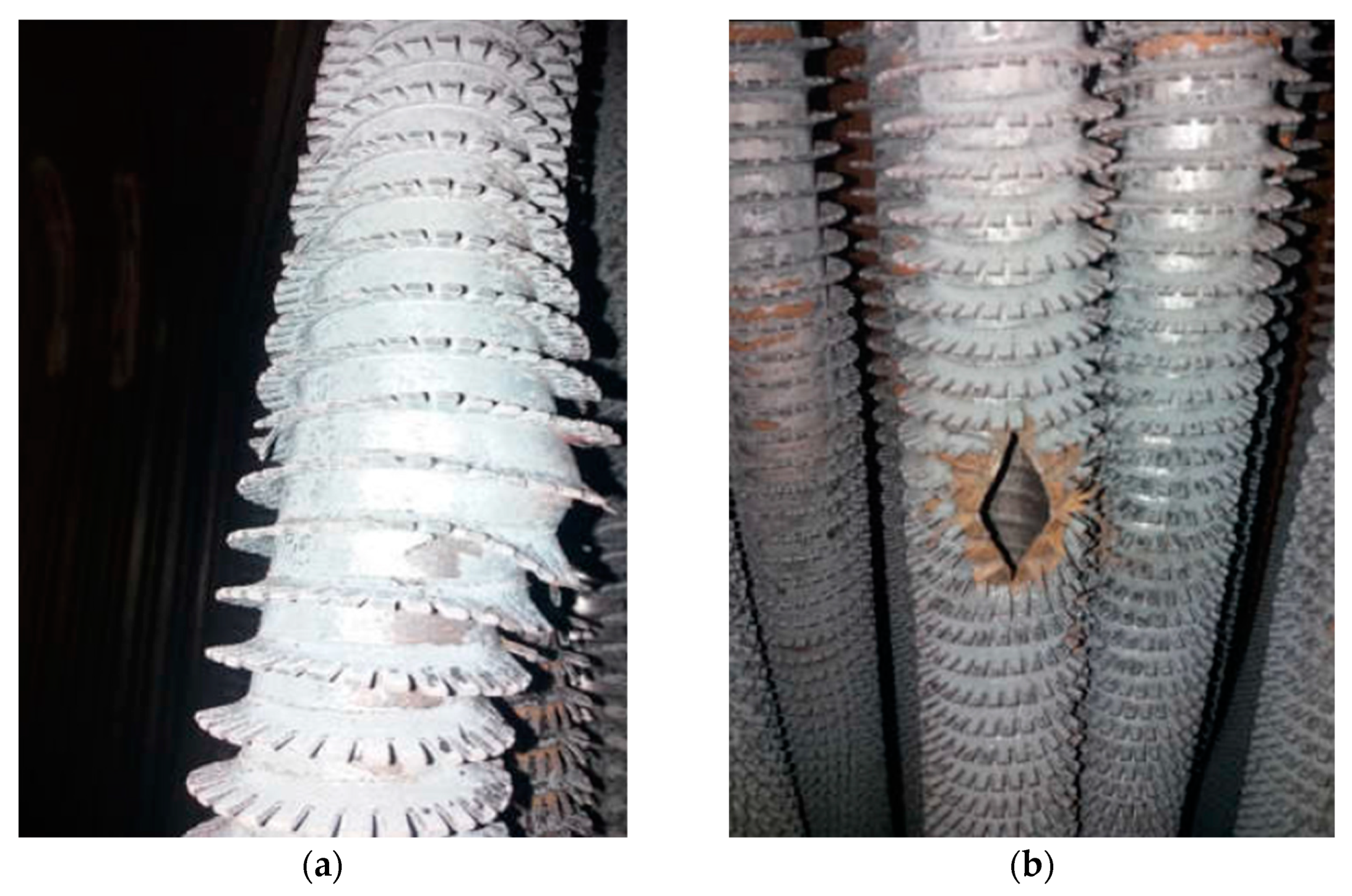
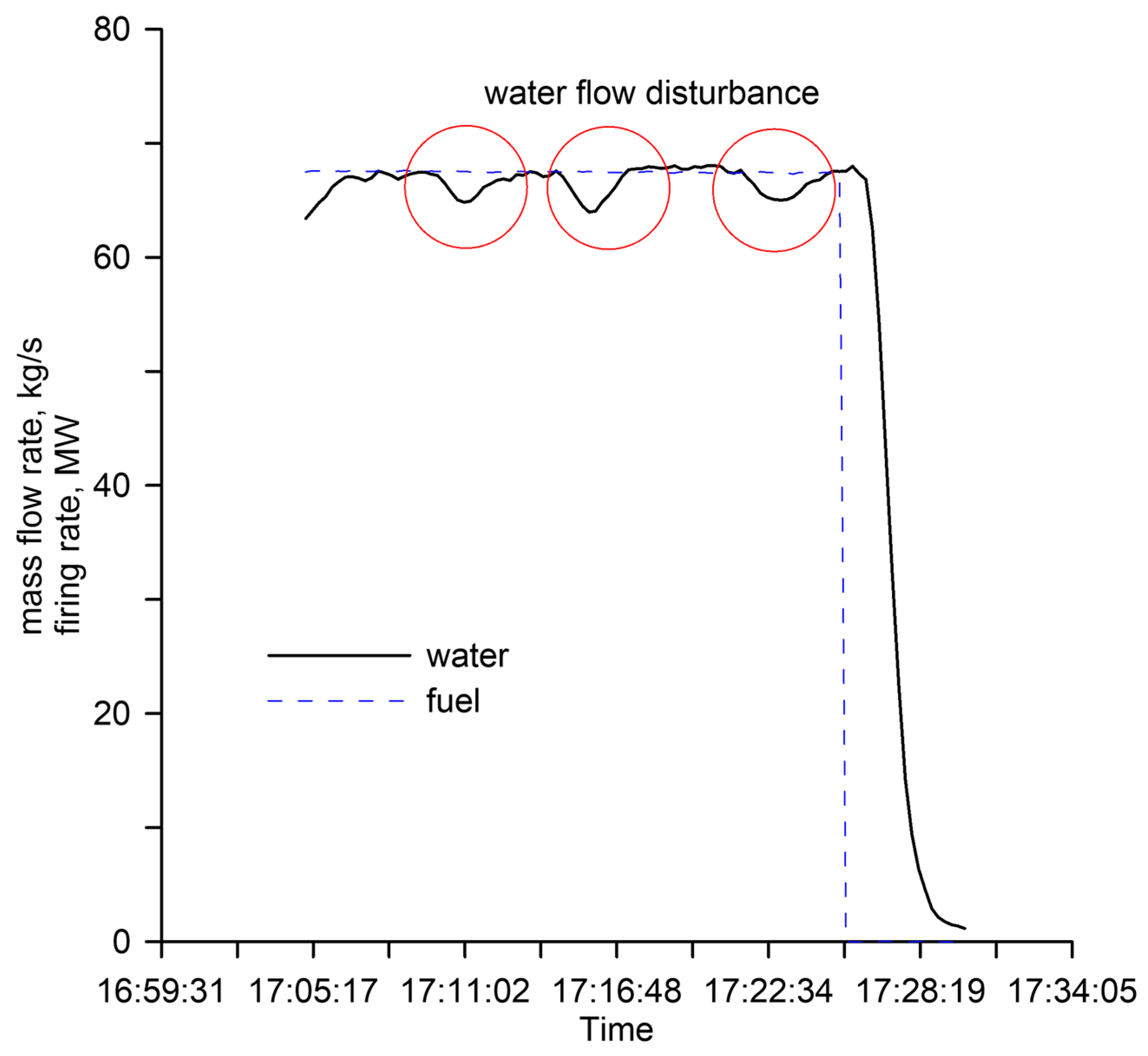

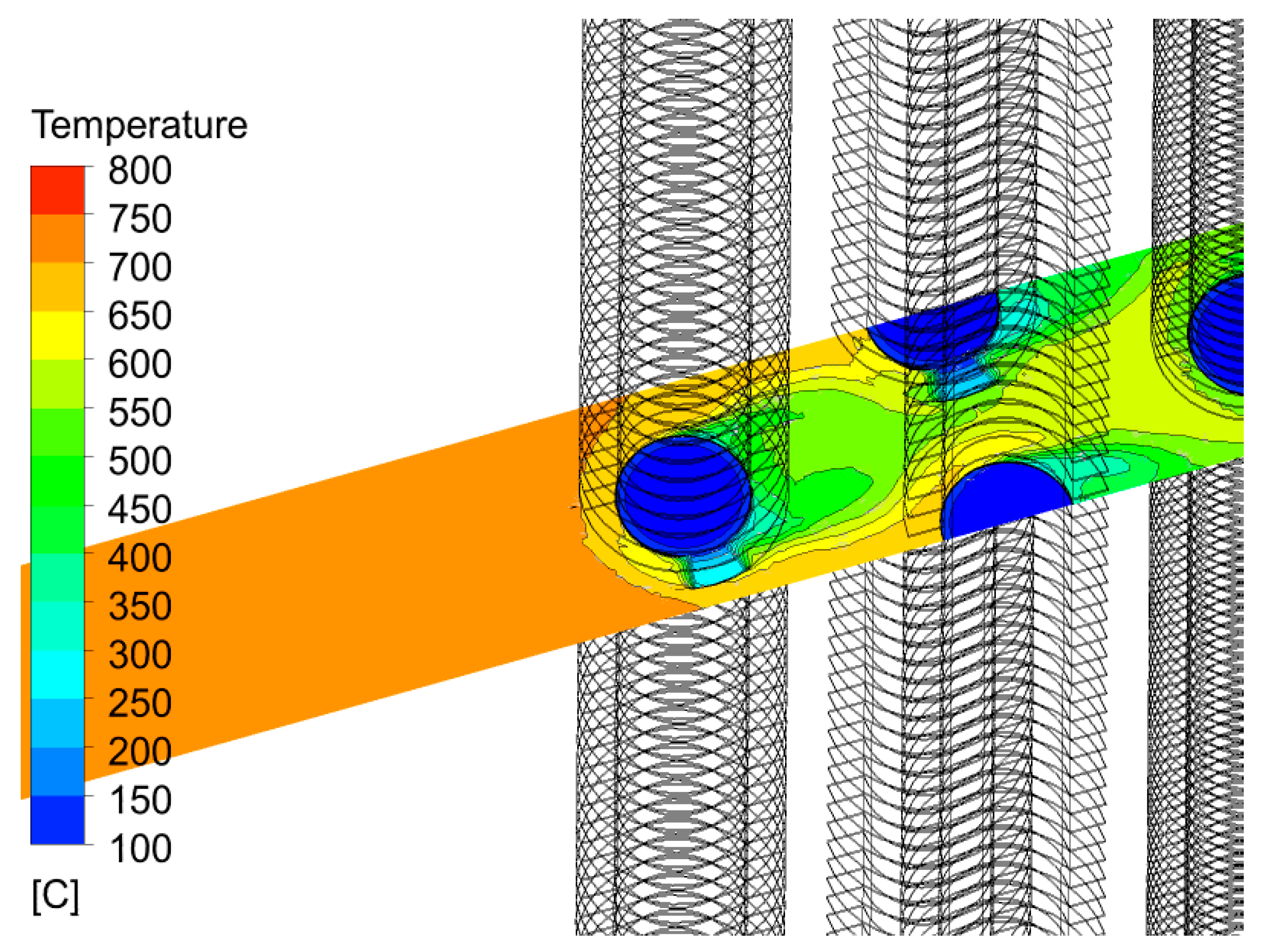
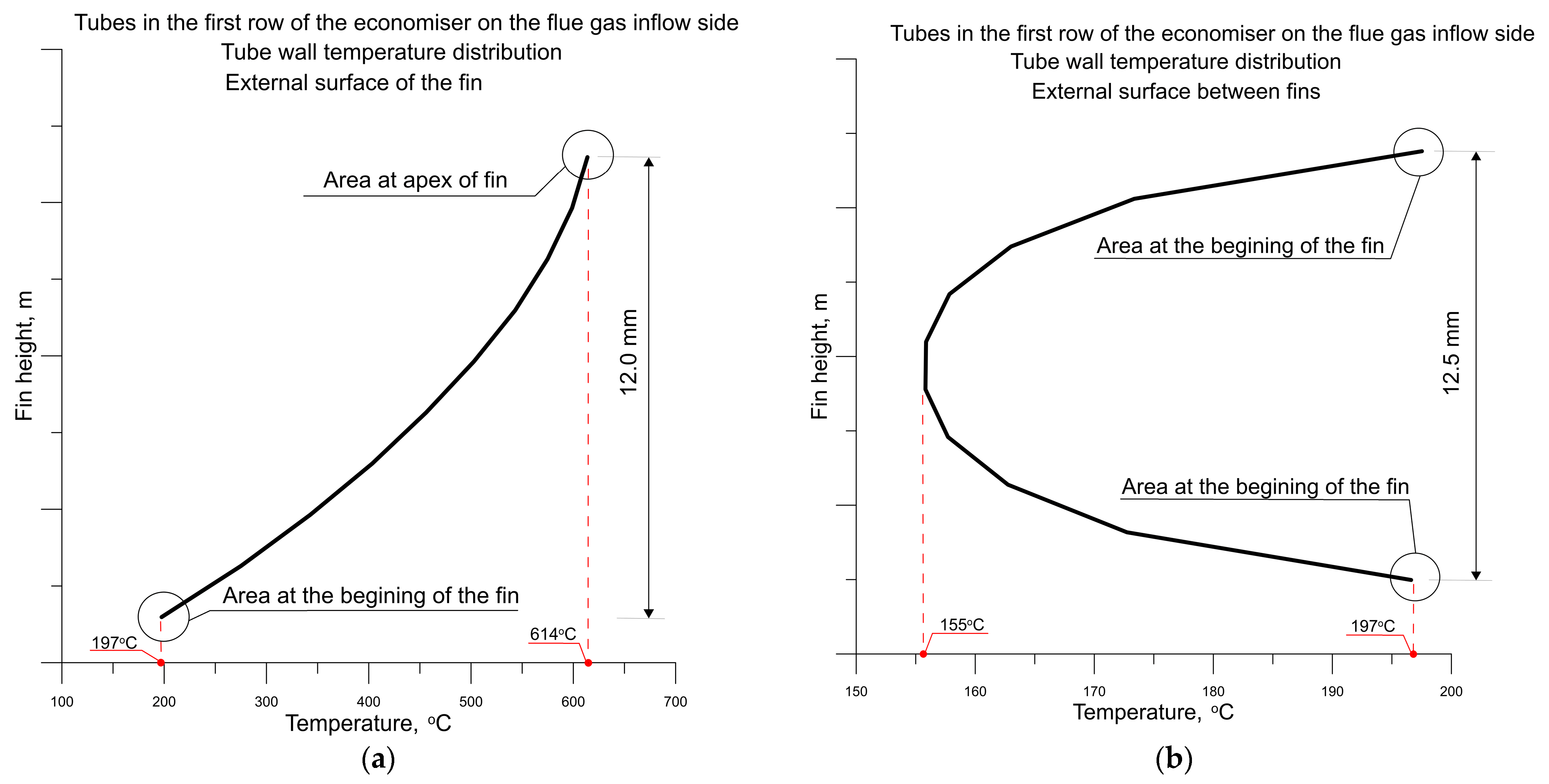






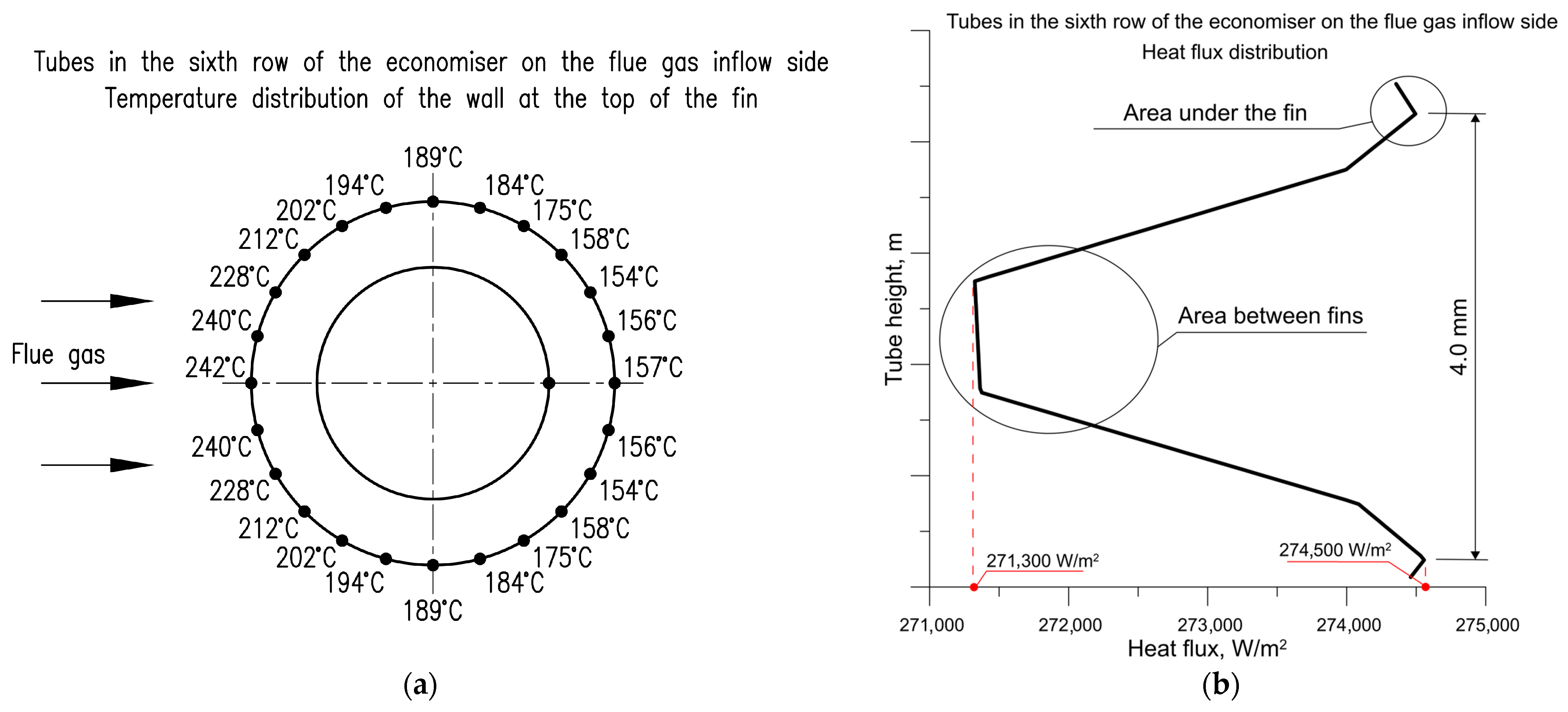



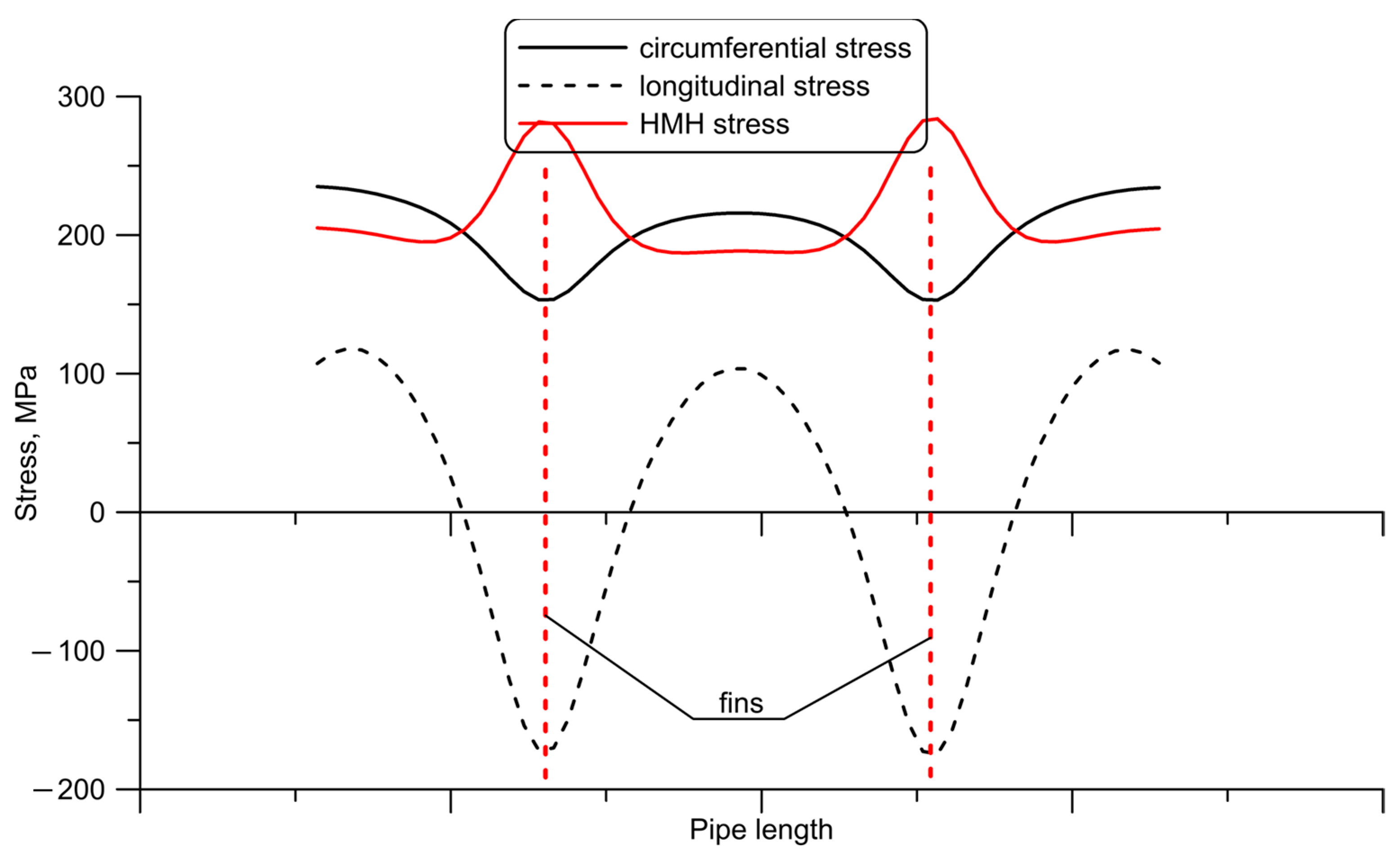

| Domain Name | Orthogonal Angle | Expansion Factor | Aspect Ratio | ||||||
|---|---|---|---|---|---|---|---|---|---|
| Min. (deg) | Maximum | Maximum | |||||||
| FlueGas | 35.5 | 93 | 20 | ||||||
| Water | 75.5 | 14 | 654 | ||||||
| Pipe | 39.9 | 11 | 46 | ||||||
| Global | 35.5 | 93 | 654 | ||||||
| bad (%) | ok (%) | good (%) | bad (%) | ok (%) | good (%) | bad (%) | ok (%) | good (%) | |
| FlueGas | 0 | <1 | 100 | <1 | 3 | 97 | 0 | 0 | 100 |
| Water | 0 | 0 | 100 | 0 | 6 | 94 | 0 | 0 | 100 |
| Pipe | 0 | 0 | 100 | 0 | <1 | 100 | 0 | <1 | 100 |
| Global | 0 | <1 | 100 | <1 | 4 | 96 | 0 | <1 | 100 |
| Maximum Fin Temperature | Maximum Temperature of the External Surface of the Tube | Maximum Heat Flux at the Inner Surface of the Tube | |||||||||||||||
|---|---|---|---|---|---|---|---|---|---|---|---|---|---|---|---|---|---|
| °C | °C | W/m2 | |||||||||||||||
| I | II | III | IV | V | VI | I | II | III | IV | V | VI | I | II | III | IV | V | VI |
| 614 | 321 | 281 | 277 | 254 | 242 | 197 | 145 | 139 | 156 | 163 | 141 | 542,700 | 254,500 | 237,800 | 232,800 | 274,500 | - |
| T, °C | 50 | 100 | 150 | 200 | 250 | 300 | 350 | 400 |
| Re0.2, MPa | 206 | 190 | 180 | 170 | 150 | 130 | 120 | 110 |
| T, °C | 1% Elongation Limit, MPa | Creep Resistance, MPa | |||
|---|---|---|---|---|---|
| 10,000 h | 100,000 h | 10,000 h | 100,000 h | 200,000 h | |
| 380 | 164 | 118 | 229 | 165 | 145 |
| 390 | 150 | 106 | 211 | 148 | 129 |
| 400 | 136 | 95 | 191 | 132 | 115 |
| 410 | 124 | 84 | 174 | 118 | 101 |
| 420 | 113 | 73 | 158 | 103 | 89 |
| 430 | 101 | 65 | 142 | 91 | 78 |
| 440 | 91 | 57 | 127 | 79 | 67 |
| 450 | 80 | 49 | 113 | 69 | 57 |
| 460 | 72 | 42 | 100 | 59 | 48 |
| 470 | 62 | 35 | 86 | 50 | 40 |
| 480 | 53 | 30 | 75 | 42 | 33 |
| Maximum Fin Temperature | Maximum Temperature of the External Surface of the Tube | Maximum Heat Flux at the Inner Surface of the Tube | |||||||||||||||
|---|---|---|---|---|---|---|---|---|---|---|---|---|---|---|---|---|---|
| °C | °C | W/m2 | |||||||||||||||
| I | II | III | IV | V | VI | I | II | III | IV | V | VI | I | II | III | IV | V | VI |
| - | - | 330 | 298 | 273 | 252 | 151 | 124 | 148.4 | 140 | 145 | 142.6 | 337,200 | 160,500 | 290,160 | 250,700 | 315,000 | 286,500 |
| Flue Gas Bulk Temperature, °C | |||||||
|---|---|---|---|---|---|---|---|
| Behind Festoon | Behind the 1st Row | Behind the 2nd Row | Behind the 3rd Row | Behind the 4th Row | Behind the 5th Row | Behind the 6th Row | |
| Actual layout (1st and 2nd row finned tubes) | 985 | 849 | 777 | 691 | 608 | 510 | 417 |
| recommended solution (1st and 2nd row smooth pipes) | 985 | 872 | 837 | 744 | 656 | 544 | 445 |
Disclaimer/Publisher’s Note: The statements, opinions and data contained in all publications are solely those of the individual author(s) and contributor(s) and not of MDPI and/or the editor(s). MDPI and/or the editor(s) disclaim responsibility for any injury to people or property resulting from any ideas, methods, instructions or products referred to in the content. |
© 2023 by the authors. Licensee MDPI, Basel, Switzerland. This article is an open access article distributed under the terms and conditions of the Creative Commons Attribution (CC BY) license (https://creativecommons.org/licenses/by/4.0/).
Share and Cite
Trojan, M.; Dzierwa, P.; Taler, J.; Granda, M.; Kaczmarski, K.; Taler, D.; Sobota, T. Analysis of the Causes of the Emergency Shutdown of Natural Gas-Fired Water Peak Boilers at the Large Municipal Combined Heat and Power Plant. Energies 2023, 16, 6278. https://doi.org/10.3390/en16176278
Trojan M, Dzierwa P, Taler J, Granda M, Kaczmarski K, Taler D, Sobota T. Analysis of the Causes of the Emergency Shutdown of Natural Gas-Fired Water Peak Boilers at the Large Municipal Combined Heat and Power Plant. Energies. 2023; 16(17):6278. https://doi.org/10.3390/en16176278
Chicago/Turabian StyleTrojan, Marcin, Piotr Dzierwa, Jan Taler, Mariusz Granda, Karol Kaczmarski, Dawid Taler, and Tomasz Sobota. 2023. "Analysis of the Causes of the Emergency Shutdown of Natural Gas-Fired Water Peak Boilers at the Large Municipal Combined Heat and Power Plant" Energies 16, no. 17: 6278. https://doi.org/10.3390/en16176278
APA StyleTrojan, M., Dzierwa, P., Taler, J., Granda, M., Kaczmarski, K., Taler, D., & Sobota, T. (2023). Analysis of the Causes of the Emergency Shutdown of Natural Gas-Fired Water Peak Boilers at the Large Municipal Combined Heat and Power Plant. Energies, 16(17), 6278. https://doi.org/10.3390/en16176278








